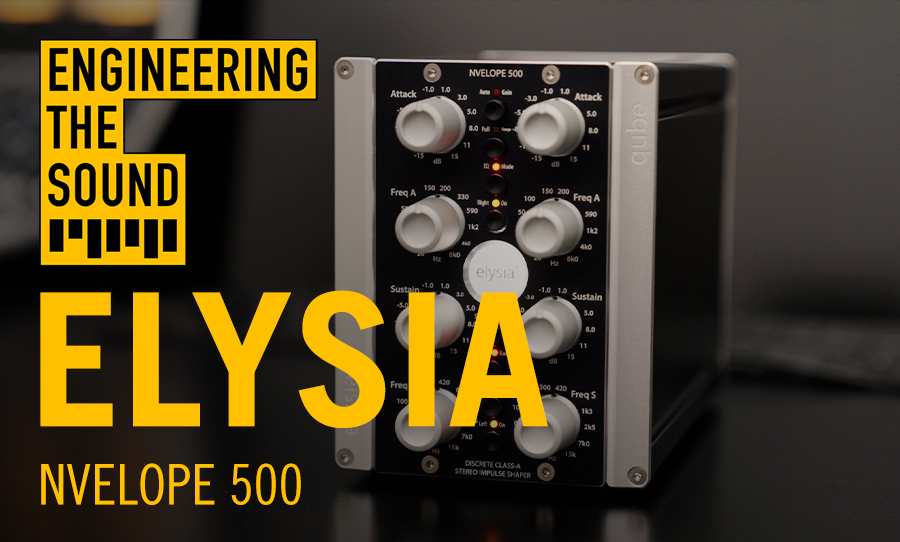If you’ve ever dived deep into transient shaping, you’ll know there aren’t many units that approach it with the surgical precision of the elysia nvelope 500.
Sitting proudly in its sleek 500 series enclosure — or even more flexibly in elysia’s own qube desktop chassis — the nvelope 500 is a dynamic sculpting powerhouse that offers an almost surgical level of control over attack and sustain. But what makes this box so special? Let’s get into it.
🏗️ A Bit of Background
elysia was founded in 2005 by Ruben Tilgner, a name already familiar to many audio engineers thanks to his earlier work at SPL, where he was instrumental in developing the original Transient Designer. That invention was groundbreaking, offering engineers the ability to manipulate attack and sustain independently — and ultimately changing how we approach dynamic processing.
With the nvelope 500, Tilgner and the elysia team have taken transient control even further, packing an extraordinary range of options into a deceptively compact form factor.
🔎 What Exactly Does the nvelope 500 Do?
At its core, the nvelope 500 is a transient designer and EQ, but calling it just that would be selling it short. The unit operates in both stereo and dual mono, giving you flexibility depending on your session. And while its interface might look intimidating at first — two channels, four knobs per side, eight centre-mounted switches — once you wrap your head around its architecture, you’ll realise just how intuitive and musical it is.
The nvelope 500 operates in three primary modes:
1️⃣ Full Range Mode:
Attack and sustain shaping across the entire frequency range. Perfect for global transient control.
2️⃣ Dual Band Mode:
Splits your signal into two frequency zones, allowing you to treat highs and lows independently. This is where things get seriously powerful, letting you target problem areas or enhance specific parts of your spectrum.
3️⃣ EQ Mode:
Turns the unit into a two-band shelving EQ. Here, the Attack and Sustain knobs function as high and low boost/cut controls, while the frequency knobs select where these boosts or cuts occur.
🎛️ The Controls Explained
Each channel features:
-
Attack: Adjusts how aggressive or subdued your transients are. In Full Range and Dual Band modes, this directly shapes the attack.
-
Sustain: Alters the decay or tail of your signal, either extending or shortening it.
-
Freq A & Freq S:
-
In Full Range Mode: Freq A sets which frequencies are impacted by Attack.
-
In Dual Band Mode: Freq A determines where Attack processing starts, and Freq S sets where Sustain processing ends.
-
In EQ Mode: Both frequency controls adjust the shelving EQ frequency points.
-
On top of these, several key switches unlock even more control:
-
Auto Gain: Helps maintain consistent levels when working in Full Range Mode.
-
Full Range/Dual Band Toggle: Lets you easily switch between the two transient modes.
-
Stereo Link: Allows both channels to be controlled together or run completely independently (known as Mixed Mode). In Mixed Mode, one channel can be in EQ mode while the other works in Dual Band or Full Range.
-
Bypass (On/Off): Separate for each channel, for true A/B comparisons.
🎯 Real-World Use
So what’s it like when you actually start using the nvelope 500? In a word: surgical. This isn’t a blunt instrument for squashing drums or aggressively smashing transients (though it can be that, too). Instead, the nvelope excels at fine-tuning the contour of your sound:
-
Need to add snap to a kick without affecting the low-end mud? ✅
-
Want to reduce harsh cymbal tails while keeping the initial shimmer? ✅
-
Trying to breathe life into lifeless synths or vocals? ✅
And because you can split the processing by frequency in Dual Band mode, you get an almost unmatched level of precision.
Even the EQ mode feels like a bonus: smooth, musical, and useful when you just need subtle tone shaping without bringing another EQ into your chain.
💼 Portability with the qube 🧳
Don’t have a full 500 series rack? No problem. elysia offers the qube chassis, allowing you to house a single stereo 500 series module or two mono modules in a compact desktop format. It’s perfect for mobile setups, smaller studios, or engineers who want top-tier analog control without investing in an entire rack system.
💰 Price and Value
The elysia nvelope 500 currently retails for $1666 AUD, which for this level of build quality and control is extremely reasonable. If you’re serious about transient shaping, drum mixing, mastering, or even just adding a unique flavour to your dynamic processing, the nvelope absolutely earns its rack (or qube) space.
📝 Final Thoughts
The elysia nvelope 500 isn’t just another transient designer — it’s a precision tool for serious engineers who want full control over how sound moves, breathes, and lives in a mix. Yes, there’s a bit of a learning curve, but once you understand its modes and controls, you’ll be reaching for it again and again. Whether you’re adding punch, taming sustain, or subtly shaping complex material, the nvelope 500 delivers.
🎚️✨ Punchy. Subtle. Surgical. The nvelope 500 is a modern classic.



